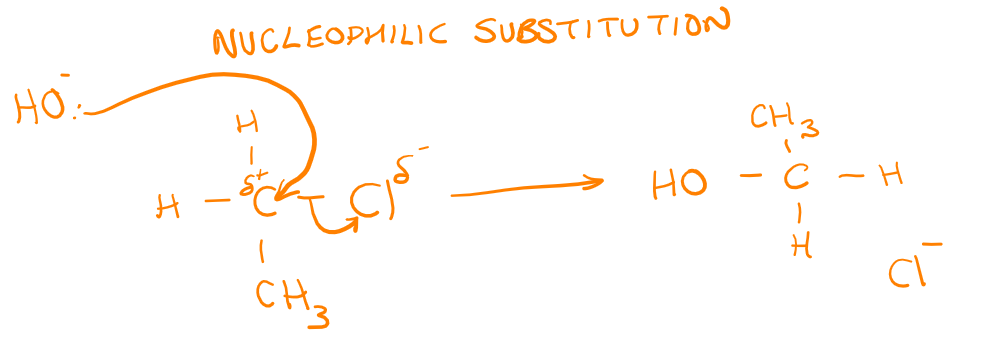Module 4 - Core Organic Chemistry
1/65
Earn XP
Description and Tags
Introduction to organic chemistry, alkanes, alkenes and alcohols
Name | Mastery | Learn | Test | Matching | Spaced |
|---|
No study sessions yet.
66 Terms
[4.1.1] What is meant by the term 'general formula’?
The simplest algebraic formula of a member of a homologous series, e.g. for an alcohol: CₙH₂ₙ₊₁OH.
[4.1.1] What is meant by the term 'structural formula’?
The minimal detail that shows the arrangement of atoms in a molecule, e.g. for butane: CH₃(CH₂)₂CH₃.
[4.1.1] What is meant by the term 'displayed formula’?
The relative positioning of atoms and the bonds between them, e.g. for ethanol:
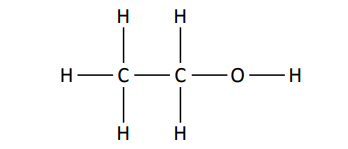
[4.1.1] What is meant by the term 'skeletal formula’?
The simplified organic formula, shown by removing hydrogen atoms from the alkyl chains, leaving just a carbon skeleton and associated functional groups, e.g. for butan-2-ol:
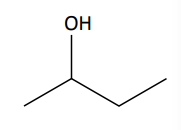
[4.1.1] What is meant by the term 'homologous series’?
A series of organic compounds with the same functional group but with each successive member differing by CH₂.
[4.1.1] What is meant by the term 'functional group’?
A group of atoms responsible for the characteristic reactions of a compound.
[4.1.1] What is meant by the term 'alkyl group’?
Of formula CₙH₂ₙ₊₁.
[4.1.1] What is meant by the term 'aliphatic'?
A compound containing carbon and hydrogen joined together in straight chains, branched chains, or non-aromatic rings.
[4.1.1] What is meant by the term 'alicyclic’?
An aliphatic compound arranged in non-aromatic rings with or without side chains.
[4.1.1] What is meant by the term 'aromatic’?
A compound containing a benzene ring.
[4.1.1] What is meant by the term 'saturated’?
Contains single carbon-carbon (C-C) bonds only.
[4.1.1] What is meant by the term 'unsaturated’?
Contains multiple carbon-carbon (C-C) bonds, including C=C, C≡C and aromatic rings.
[4.1.1] What are the symbols for Benzene?
Cyclohexane with circle inside it or alternating single & double bonds
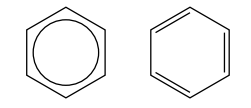
[4.1.1] What is ‘structural isomerism’?
Compounds with the same molecular formula but have a different structural formula
[4.1.1] What is a curly arrow used to represent?
The movement of a pair of electrons. Curly arrows have to start either in a lone pair, a bond or a negative charge.
[4.1.1] What is homolytic fission?
Each bonding atom receives one electron from the bonded pair, forming two radicals.

[4.1.1] What is heterolytic fission?
One bonding atom receives BOTH electrons from the bonded pair.

[4.1.1] Which groups are partially negative when bonded to carbon?
Oxygen and group 7 elements.
[4.1.1] What is a free radical?
A species with an unpaired electron.
'Dots' are used to represent species that are radicals within mechanisms.
[4.1.1] What is a dipole?
A separation in electrical charge so that one atom of a polar covalent bond, or one end of a polar molecule, has a small positive charge and the other has a small negative charge.
[4.1.1] What is an elimination reaction?
The reverse of an addition reaction, usually a smaller molecule is said to have been eliminated.

[4.1.2] What is an alkane?
A saturated hydrocarbon containing sigma bonds (σ) which rotate freely.
[4.1.2] What is a sigma bond?
A σ bond is the overlap of orbitals directly between bonding atoms.
[4.1.2] How does alkane branching affect their boiling points?
More highly branched = lower boiling points as lower surface contact
[4.1.2] How does alkane chain length affect their boiling points?
Longer alkanes = higher boiling points as more London forces due to increased surface area
[4.1.2] What is complete combustion?
Carbon and hydrogen combine with oxygen to produce carbon dioxide and water in an exothermic reaction.
[4.1.2] What is incomplete combustion?
Incomplete combustion of a hydrocarbon fuel occurs when there is a poor supply of oxygen. The products can be carbon dioxide, carbon monoxide or carbon particulates.
[4.1.2] What is needed for the halogenation of an alkane?
Ultraviolet Radiation.
[4.1.2] What is the name of the mechanism used for the halogenation of an alkane?
Radical Substitution.
[4.1.2] What are the limitations of free radical subsitution?
It is difficult to synthesise just one specific organic compound because:
Further substitution can take place.
Longer carbon chains lead to a mixture of isomers.
[4.1.3] What is an alkene?
An unsaturated hydrocarbon with the general formula CₙH₂ₙ.
[4.1.3] What is a pi bond?
A π-bond consists of the sideways overlap of adjacent p-orbitals above and below bonding carbon atoms.
It locks the two carbon atoms in position and prevents them from rotating.
[4.1.3] What is stereoisomerism?
Compounds with the same structural formula but a different arrangement in space.
[4.1.3] What is E/Z Isomerism?
The C=C bond has 2 different groups attached to it.
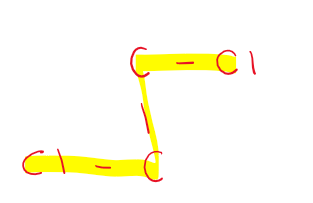
[4.1.3] What is Cis/Trans Isomerism?
Two of the substituent groups attached to each carbon atom of the C=C group are the same;
Cis → 2 identical groups are on the same side of C=C.
Trans → 2 identical groups are on the opposite side of C=C.
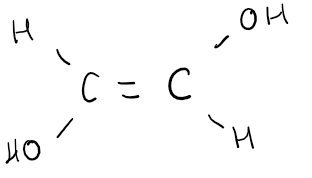
[4.1.3] When is E/Z equivalent to Cis/Trans?
E is equivalent to Trans.
Z is equivalent to Cis.
This is only consistently correct when there is a H on each carbon atom of the C=C bond.
[4.1.3] What are the Cahn-Ingold-Prelog (CIP) rules?
These rules can identify E/Z isomerism.
\
The priority group of each carbon is the one with the largest atomic number, the positioning of the carbon priority groups is responsible for identification of the E/Z isomerism.
[4.1.3] How does the reactivity of alkenes compare to that of alkanes?
The π-electrons are more exposed than the σ-electrons. This means that it is easier to break the π-bond than the σ-bond; it requires less energy.
[4.1.3] What is an addition reaction?
Joining two or more groups together to give a single product.
Addition reactions have an atom economy of 100%.
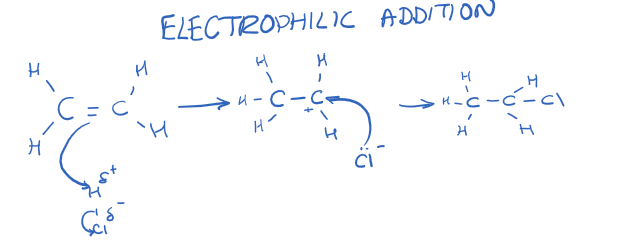
[4.1.3] What is produced in alkene hydrogenation?
An alkane.
[4.1.3] What are the conditions required for the addition reaction of alkenes with hydrogen?
The hydrogenation of an alkene requires a nickel catalyst and temperatures of 420K
[4.1.3] What is produced in alkene halogenation?
A haloalkane.
[4.1.3] How do we test for unsaturation of a carbon chain?
- Add bromine water (orange colour)
- Bromine adds across the double bond.
- The orange colour disappears.
[4.1.3] What is produced when an alkene reacts with a hydrogen halide?
They undergo an addition reaction to produce a haloalkane.
[4.1.3] What is the process of an alkene hydration reaction?
Alkenes react with steam, with a phosphoric acid catalyst - the steam adds across the double bond.
[4.1.3] What is produced in an alkene hydration reaction?
An alcohol.
[4.1.3] What is an electrophile?
An atom (or group of atoms) which is attracted to an electron-rich centre or atom, where it accepts a pair of electrons to form a new covalent bond.
[4.1.3] What is an electrophilic addition reaction?
A reaction in which a substrate is attacked by an electrophile.
[4.1.3] What is the mechanism for electrophilic addition in alkenes?

[4.1.3] What is Markownikoff’s rule?
When a hydrogen halide reacts with an unsymmetrical alkene, the hydrogen of the hydrogen halide attaches itself to the carbon atom of the alkene with the greater number of hydrogen atoms and the smaller number of carbon atoms.
[4.1.3] How do we determine the major product of an alkene reaction?
A tertiary carbocation is more stable than a secondary and primary carbocation so will form the major product.
[4.1.3] What is an addition polymer?
The reaction in which many monomers containing at least one C=C double bond form long chains of polymers as the only product.
[4.1.3] What are the benefits of the combustion of waste polymers?
Polymers that are unrecyclable often have a high stored energy value; they are incinerated to produce heat, which generates steam to drive turbines which produce electricity.
[4.1.3] What are the benefits of feedstock recycling?
Feed-stock recycling breaks down polymers without separating them, forming simple gases that can then be used to manufacture pure, fresh polymers.
[4.1.3] What are biodegradable polymers?
Biodegradable polymers are broken down by microorganisms into water, carbon dioxide, and other biological compounds.
These polymers are usually made from starch or cellulose.
Compostable polymers degrade and leave no visible/toxic residue.
[4.1.3] What are photodegradable polymers?
These polymers contain bonds that are weakened by the absorption of light to begin the degradation process.
[4.2.1] What is an alcohol?
Alcohols contain the functional group ‘-OH’ where the oxygen is joined to a carbon by a single covalent bond.
Prefix - “Hydroxy”
Suffix - “-ol”
The related functional groups include “one”, “al”, “oic acid”, “thyl”, “anoate”.
[4.2.1] How can alcohols be classified?
Alcohols are classified based on the number of carbons attached to the carbon that the -OH group is on.
Three Carbons → Tertiary Alcohol
Two Carbons → Secondary Alcohol
One or None → Primary Alcohol
e.g. 2-methylpropan-2-ol is a tertiary alcohol and ethanol is a primary alcohol.
[4.2.1] What is the oxidising mixture?
Acidified Potassium Dichromate
K₂Cr₂O₇/H₂SO₄
The oxidising mixture can be represented by [O].
[4.2.1] What are the first oxidation products of a primary alcohol?
An aldehyde and water.
[4.2.1] What is the further oxidation product of a primary alcohol?
A carboxylic acid.
[4.2.1] What is the first oxidation product of a secondary alcohol?
A ketone and water.
[4.2.1] How do we prevent further oxidations?
By using continuous distillation.
[4.2.1] How do we collect the final oxidation product?
Reflux.
[4.2.2] What is a nucleophile?
An atom (or group of atoms) which is attracted to an electron-deficient centre or atom, where it donates a pair of electrons to form a new covalent bond.
[4.2.2] What is a substitution reaction?
Swapping one group for another.
